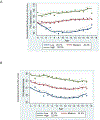Trajectory Analysis of Cognitive Outcomes in Children With Perinatal HIV
- PMID: 31568142
- PMCID: PMC6776249
- DOI: 10.1097/INF.0000000000002427
Trajectory Analysis of Cognitive Outcomes in Children With Perinatal HIV
Abstract
Background: Children with perinatal HIV (pHIV) may display distinct long-term cognitive phenotypes. We used group-based trajectory modeling to identify clusters of children with pHIV after similar developmental trajectories and predictors of belonging to select cognitive trajectory groups.
Methods: Participants included children, 4-17 years of age, with pHIV in Thailand and Cambodia. Cognitive measures included translated versions of Intelligence Quotient tests, Color Trails Tests and Beery-Buktenica Developmental Test of Visual-Motor Integration conducted semiannually over 3-6 years. The best fit of trajectory groups was determined using maximum likelihood estimation. Multivariate logistic regression identified baseline factors associated with belonging to the lowest scoring trajectory group.
Results: Group-based trajectory analyses revealed a 3-cluster classification for each cognitive test, labeled as high, medium and low scoring groups. Most trajectory group scores remained stable across age. Verbal IQ declined in all 3 trajectory groups and the high scoring group for Children's Color Trails Test 1 and 2 showed an increase in scores across age. Children in the lowest scoring trajectory group were more likely to present at an older age and report lower household income.
Conclusions: Group-based trajectory modeling succinctly classifies cohort heterogeneity in cognitive outcomes in pHIV. Most trajectories remained stable across age suggesting that cognitive potential is likely determined at an early age with the exception of a small subgroup of children who displayed developmental gains in select cognitive domains and may represent those with better cognitive reserve. Poverty and longer duration of untreated HIV may predispose children with pHIV to suboptimal cognitive development.
Conflict of interest statement
Figures



References
-
- Cohen S, Ter Stege JA, Geurtsen GJ, et al. Poorer cognitive performance in perinatally HIV-infected children versus healthy socioeconomically matched controls. Clin Infect Dis. 2015;60(7):1111–1119. - PubMed
-
- Lindsey JC, Malee KM, Brouwers P, et al. Neurodevelopmental functioning in HIV-infected infants and young children before and after the introduction of protease inhibitor-based highly active antiretroviral therapy. Pediatrics. 2007;119(3):e681–693. - PubMed
-
- Nagin D Group-based modeling of development. Cambridge, Mass.: Harvard University Press; 2005.
Publication types
MeSH terms
Grants and funding
LinkOut - more resources
Full Text Sources
Medical

